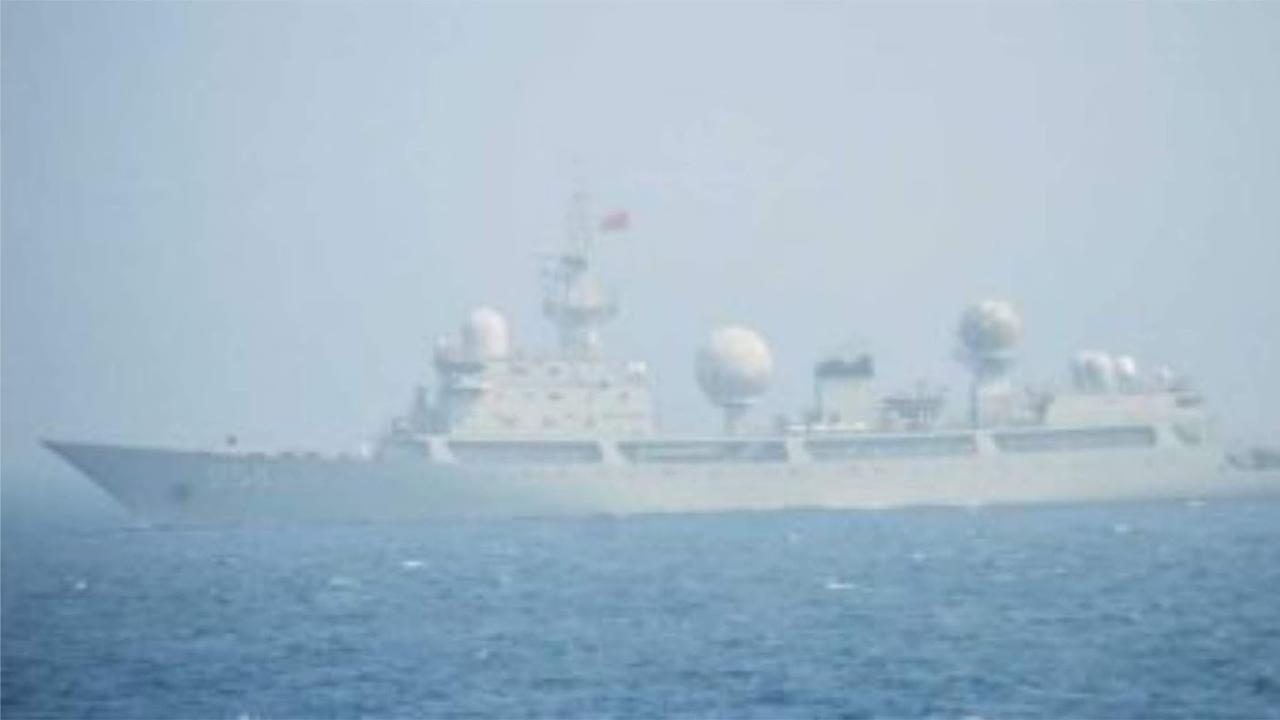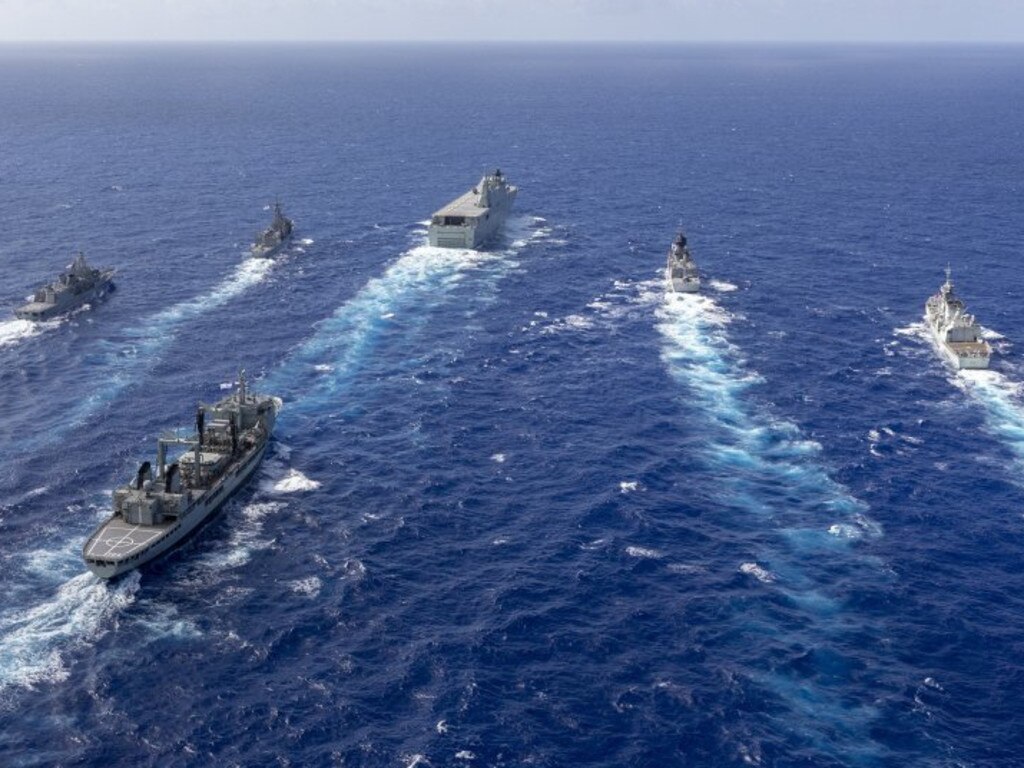Chinese spy ship observes Japan, US, Australia ‘sinking’ old warship
AUSTRALIA just helped sink a major warship. And the Chinese — who had been ‘disinvited’ shortly before a new round of war games kicked off, were watching.
IT was the spectacle of the show: a series of missiles and torpedoes slammed into what was once a major ship of war — an assault ship designed to deploy tanks and troops on the front line.
Missile thrusters roared. Contrails streaked through the skies above.
They had been launched from Japanese and US trucks parked on Hawaii testing grounds.
Their target, the ex USS Racine, lay in the water some 100km to the north.
The key Pacific allies were working in concert during RIMPAC 2018 — one of the biggest war games in the region for the year.
...and then...🤔 pic.twitter.com/aDqFqiV2T4
— RIMPAC (@RimofthePacific) July 15, 2018
A Japanese P-3 Orion search aircraft ‘acquired’ the target. But it was ‘jammed’ and unable to complete its report.
So a US Army Gray Eagle unmanned drone flew off under the direction of an AH-64 Apache attack helicopter to verify the sighting.
These then relayed targeting data to the paired US and Japanese missile trucks — and an Australian P-8A Poseidon maritime reconnaissance aircraft.

The Australian Poseidon reportedly fired a Harpoon missile. Australian warships were among those nearby, acting in support.
Then the attack submarine USS Olympia fired a Harpoon missile and a Mk-48 torpedo to finish the job.
It's a HIT! 🎯
— RIMPAC (@RimofthePacific) July 16, 2018
Live fire from aircraft, a submarine, and land assets have sunk the decommissioned the Tank Landing Ship, ex-USS Racine, during the Sinking Exercise, or SINKEX.#RIMPAC #RIMPAC2018 #CapableAdaptivePartners pic.twitter.com/6cMhxG0GXN
“First time ever in history. That’s pretty unique,” said the commander of the US Army in the Pacific, General Robert Brown, of the allied co-ordination.
The missiles inflicted great damage to the gutted hulk.
But it was a submarine launched torpedo that spectacularly broke the old landing ship tank’s back.

UNWELCOME EYES
China’s continued belligerence in the face of international opposition to its arbitrary claims over the whole of the South and East China Seas saw its navy ‘disinvited’ from the RIMPAC 2018 exercises just weeks before they were due to kick off.
So Beijing sent a spy ship instead.
The Chinese People’s Liberation Army Navy (PLAN) Type 815 Dongdiao-class surveillance vessel has been operating legally in international waters surrounding the high-level military war-games, monitoring movements, sensors and communications.
EXPLORE MORE: Do Australia’s new frigates have a fighting chance?
“We expect the ship will remain outside the territorial seas of the U.S. and not operate in a manner that disrupts ongoing RIMPAC exercise,” US Pacific Fleet spokesman Captain Charlie Brown told media
“We’ve taken all precautions necessary to protect our critical information. The ship’s presence has not affected the conduct of the exercise.”

No effort has been made to move the Chinese vessel out of the area given its legal status and lack of danger to the ongoing exercise.
China, however, has not been so gracious when it comes to allowing such legal surveillance activities within the South China Sea. Its ships and aircraft regularly attempt to escort reconnaissance aircraft out of the rea.
In an effort to improve international relations, China was invited into RIMPAC for the first time in 2014. They also participated in the 2016 incarnation.
China was disinvited in May after the country’s “continued militarisation of disputed features in the South China Sea,” according to the Pentagon.
RIMPAC 2018 includes 25 countries. This year, 46 surface vessels, five submarines, 200 aircraft, and as many as 25,000 personnel are participating.

ADAPTING TO CHANGE
The test firing of the land-based anti-ship weapons is seen as something of a response to China’s fortification of artificial islands in the South China Sea, and its controversial claims over the East China Sea.
The Western allies fear that China’s land-based missiles will all but prevent warships from approaching. So, to defend key islands and sites such as Taiwan, the West has been developing its own.
Such truck-carried missiles can be easily moved between concealed firing positions. They can also readily be rearmed.
“It’s like an unsinkable aircraft carrier”, Brown said.
STORY || Duty calls for career naval officer Captain Blair Gerritsen this month as he takes command of a naval Task Group larger than our Navy's fleet for the world’s largest international maritime exercise, @RimofthePacific.
— Royal NZ Navy (@nznavy) July 11, 2018
MORE: https://t.co/Q0Q1uKr9tA#Force4NZ #NZNavy pic.twitter.com/7136XYQIDd
“The dilemma we face is, we either have to develop new, innovative, integrated approaches to dealing with these problems — and add as many (partner nations) as we can get, or we bankrupt ourselves pursuing it,” retired Navy Captain and former director of operations for Pacific Command’s Joint Intelligence Center Carl Schuster told Military.com.
The Australian Defence Force has sent four warships, HMA Ships Adelaide, Success, Toowoomba, Melbourne, a submarine (HMAS Rankin), one P-8A Poseidon aircraft and more than 1600 personnel including an amphibious landing force from 2nd Battalion, Royal Australian Regiment to participate in RIMPAC 2018.
“As the world’s largest international maritime exercise, RIMPAC provides a unique training opportunity designed to foster and sustain cooperative relationships that are critical to ensuring the safety of sea lanes and security on the world’s interconnected oceans,” a Royal Australian Navy statement reads.




